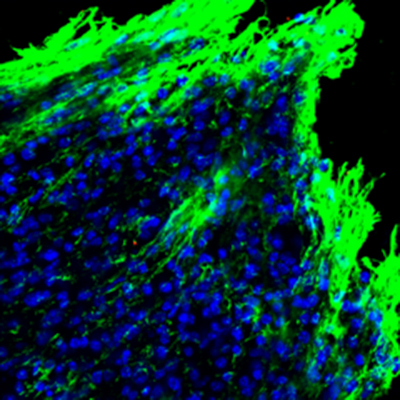Gene Identified That Blocks Healing after Spinal Cord Injury
Published Date
Article Content
An estimated 18,000 people in the United States annually suffer from new injuries to their spinal cords. Unfortunately for those afflicted in such cases, no FDA-approved therapy is currently available. Scientists at UC San Diego are looking into the body’s healing mechanisms for clues on recovery from spinal cord injury.
A new study by researchers in the Department of Neurobiology (School of Biological Sciences) has uncovered a source of potential hope in the form of a gene that is known to be involved in key developmental processes in various tissues. Receptor tyrosine kinase, or “RYK,” has been previously associated with the regeneration of axons, the long, thin extensions of nerve cells that transmit impulses. However, RYK, the researchers found, is involved in many more functions.

Extensive astrocyte branches (green) are shown at an injury site when Ryk is inhibited.
Professor Yimin Zou and colleagues have published surprising results that reveal that RYK expression inhibits wound healing, offering implications for new treatments for paralysis after spinal cord injury.
“We did not know that RYK is a target to enhance wound healing,” said Zou. “Our discovery may give rise to much needed therapeutics to help the recovery of people who have spinal cord injury.”
Since there are no treatments, there is often danger following a spinal cord injury that secondary damage will grow and lead to chronic conditions. The body’s wound healing system, which is necessary to stop secondary injuries, involves a highly coordinated response of various cell types. These include astrocytes, which are cells in the central nervous system that support a broad range of functions.

The RYK protein (white) appears on the axons (red) and astrocytes (green) in human spinal cord after a traumatic injury.
Testing in mice confirmed that RYK is a major communication hub that coordinates how astrocytes respond to injury. RYK, they found, also regulates signals from astrocytes to other cell types. During experiments in which the RYK gene was blocked, or knocked out, recovery was accelerated. “Therefore RYK is a promising therapeutic target to accelerate wound healing, promote neuronal survival and connectivity and enhance functional recovery,” the researchers conclude in their paper.
“Astrocytic RYK signaling coordinates scarring and wound healing after spinal cord injury” was published April 10, 2025 in the Proceedings of the National Academy of Sciences. The authors include Zhe Shen, Bo Feng, Wei Ling Lim, Timothy Woo, Yanlin Liu, Silvia Vicenzi, Jingyi Wang, Brian K. Kwon, and Yimin Zou. Funding was provided by National Institute of Neurological Disorders and Stroke (grants R37 NS047484 and RO1 NS105961).
Competing interest disclosure: Zou is the founder of VersaPeutics and has equity, compensation and an interim managerial role. The terms of this arrangement have been reviewed and approved by the University of California, San Diego in accordance with its conflict-of-interest policies.
Share This:
You May Also Like
Engineers Take a Closer Look at How a Plant Virus Primes the Immune System to Fight Cancer
Technology & EngineeringStay in the Know
Keep up with all the latest from UC San Diego. Subscribe to the newsletter today.



